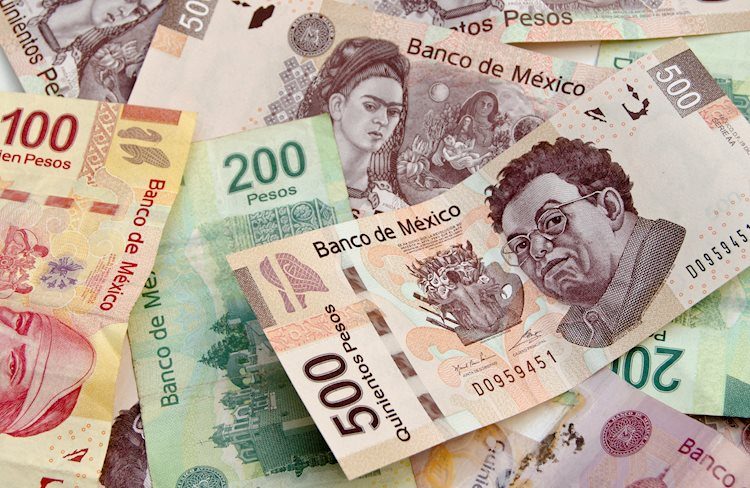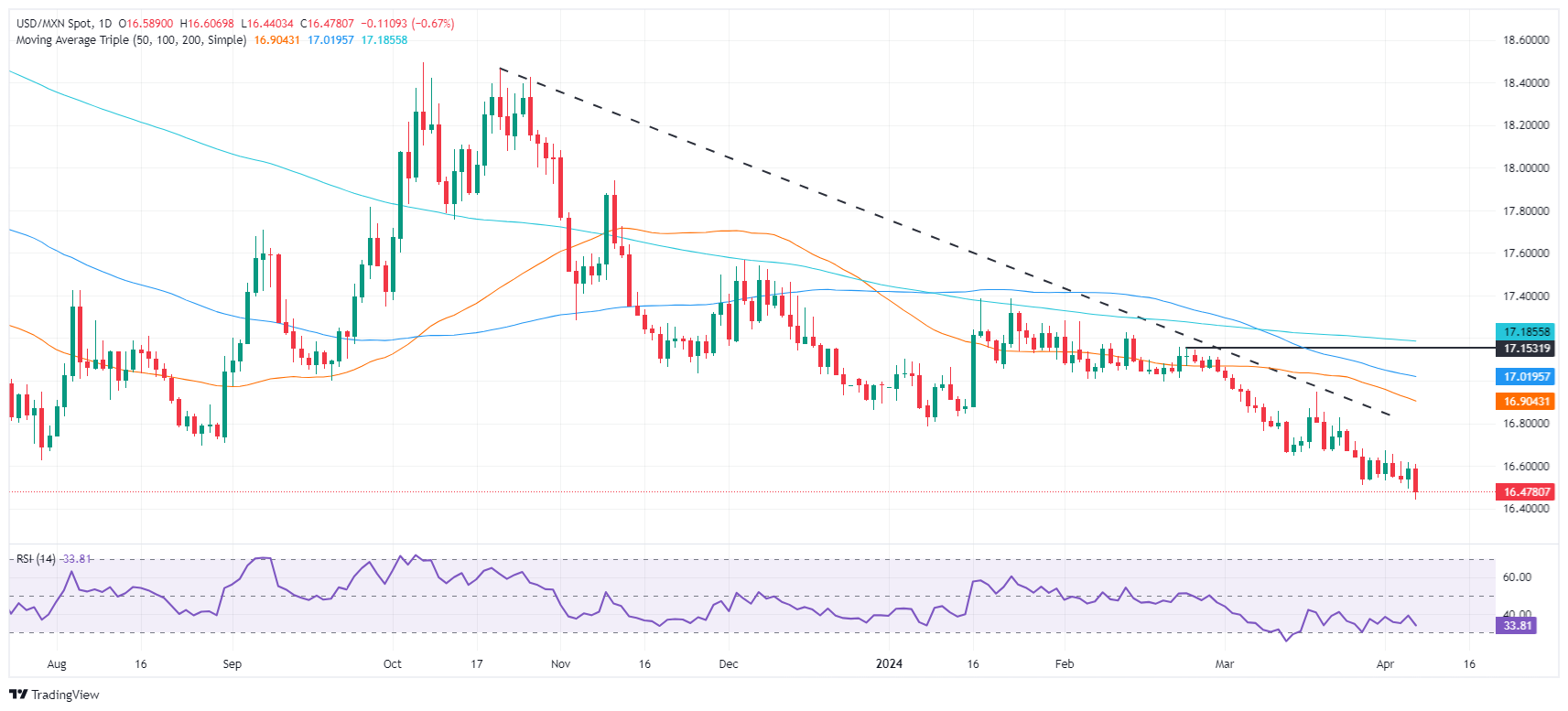- Mexican Peso strengthens against US Dollar, with USD/MXN dropping to 16.48 in reaction to upbeat US labor market figures.
- Despite a robust US jobs report, increased risk appetite drives equity gains, a tailwind for the Mexican currency.
- Fed officials maintain a cautious stance on rate adjustments, influencing market expectations for future monetary policy direction.
The Mexican Peso rallied sharply to a nine-year high on Friday after the release of a stronger-than-expected jobs report in the United States (US). Although the USD/MXN trimmed some of its losses at the release, the Peso’s resilience pressured the US Dollar. The exotic pair is currently trading at 16.44, down 0.88% after hitting a daily high of 16.60.
The USD/MXN main driver is an improvement in risk appetite even though US Nonfarm Payrolls (NFP) for March exceeded estimates and the previous month’s data. That didn’t stop traders from pushing US equities higher amid a rise in US Treasury bond yields and the US Dollar. Digging deep into the report, unemployment figures dipped, while Average Hourly Earnings were mixed. Monthly figures increased, but in the twelve months to the data, they dipped.
Given the fundamental backdrop, the swaps market suggests the US Federal Reserve will likely cut rates in July 2024. Still, the first “fully” priced-in rate cut is expected in September.
Elsewhere, Federal Reserve officials continued to emphasize that patience is needed and that they’re not in a rush to ease policy. Dallas Fed President Lorie Logan said there’s “no urgency” to cut borrowing costs, adding the risks of cutting too soon are higher than of those being late.
Daily digest market movers: Mexican Peso soars, ignoring upbeat US economic data
- The National Statistics Agency (INEGI) revealed that Mexico’s Auto Exports decreased from 22.6% in January to 4.9% in March. Additionally, Automobile Production in March plunged to a -12.8% reading from a previous 7.8% expansion, fueled by the impact of higher interest rates set by the Bank of Mexico (Banxico).
- Banxico’s minutes highlighted that Deputy Governor Irene Espinosa dissented based on inflation expectations being above the central bank’s target. The central bank lowered rates by 25 bps in March to 11.00%. Despite that, the Governing Council stated that it would remain vigilant about inflation and remain data-dependent in upcoming meetings.
- The US Bureau of Labor Statistics announced March’s Nonfarm Payrolls exceeded expectations, with a significant increase of 303K jobs compared to the anticipated 200K and the previous 270K.
- The Unemployment Rate decreased slightly to 3.8% from 3.9% with Average Hourly Earnings meeting consensus predictions.
- Following these figures, the US Dollar strengthened, evidenced by a 0.155% rise in the US Dollar Index (DXY) to 104.36. US Treasury bond yields increased by about 5 basis points, with the 10-year rate reaching 4.365%.
- Recently, Fed Governor Michelle Bowman stated that cutting rates too soon risks a rebound in inflation. She said that eventually, the bank would cut rates, yet inflationary risks are tilted to the upside. Earlier, Richmond Fed President Thomas Barkin described the NFP report as robust but noted that inflation’s reduction has been inconsistent.
Technical analysis: Mexican Peso eyes October’s 2015 high
The USD/MXN extended its losses toward the 16.40 region, though bears are gathering momentum with the Relative Strength Index (RSI) moving back below the 35.00 area, opening the door for further gains in the Peso. A breach of 16.43 would expose October’s 2015 low of 16.32, ahead of the 16.00 mark.
On the flip side, If USD/MXN bulls stepped in, they must reclaim 16.70. Once cleared, the next resistance would be the 50-day Simple Moving Average (SMA) at 16.89, with further upside seen at the 100-day SMA at 17.01, ahead of the 200-day SMA at 17.17.
Mexican Peso FAQs
The Mexican Peso (MXN) is the most traded currency among its Latin American peers. Its value is broadly determined by the performance of the Mexican economy, the country’s central bank’s policy, the amount of foreign investment in the country and even the levels of remittances sent by Mexicans who live abroad, particularly in the United States. Geopolitical trends can also move MXN: for example, the process of nearshoring – or the decision by some firms to relocate manufacturing capacity and supply chains closer to their home countries – is also seen as a catalyst for the Mexican currency as the country is considered a key manufacturing hub in the American continent. Another catalyst for MXN is Oil prices as Mexico is a key exporter of the commodity.
The main objective of Mexico’s central bank, also known as Banxico, is to maintain inflation at low and stable levels (at or close to its target of 3%, the midpoint in a tolerance band of between 2% and 4%). To this end, the bank sets an appropriate level of interest rates. When inflation is too high, Banxico will attempt to tame it by raising interest rates, making it more expensive for households and businesses to borrow money, thus cooling demand and the overall economy. Higher interest rates are generally positive for the Mexican Peso (MXN) as they lead to higher yields, making the country a more attractive place for investors. On the contrary, lower interest rates tend to weaken MXN.
Macroeconomic data releases are key to assess the state of the economy and can have an impact on the Mexican Peso (MXN) valuation. A strong Mexican economy, based on high economic growth, low unemployment and high confidence is good for MXN. Not only does it attract more foreign investment but it may encourage the Bank of Mexico (Banxico) to increase interest rates, particularly if this strength comes together with elevated inflation. However, if economic data is weak, MXN is likely to depreciate.
As an emerging-market currency, the Mexican Peso (MXN) tends to strive during risk-on periods, or when investors perceive that broader market risks are low and thus are eager to engage with investments that carry a higher risk. Conversely, MXN tends to weaken at times of market turbulence or economic uncertainty as investors tend to sell higher-risk assets and flee to the more-stable safe havens.

